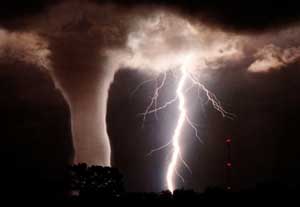How Does Lightning Cause Injuries?
Lightning can cause injuries in the following ways:
1. Lightning strikes directly at the victim from the cloud above.
2. When the victim is standing near an object that is struck by lightning. Lightning can jump through the air gap between the person and the object. This case is referred to as a side flash.
3. Lightning strikes when the victim is in contact with an object that has been struck.
4. Step voltage. When a person is in contact with the ground at a few points, lightning spreads across the ground.
5. Lightning can travel through cable lines to objects such as telephones, televisions, and electrical outlets.
According to statistics, direct lightning strikes are the most dangerous; 8 out of 10 people struck directly by lightning do not survive. Contact strikes or side flashes are also very dangerous. When lightning strikes a tree, it can kill several people nearby instantly. The level of danger depends on the nature of the object struck by lightning and the relative position to the victim. Casualties due to step voltage are less severe. In some cases, the energy from the lightning does not dissipate immediately at the site but travels along the ground, leading to paralysis if the victim is standing on that path. In severe cases, victims may face mobility issues later. Generally, step voltage only causes temporary effects and rarely leaves lasting consequences. In practice, lightning propagation often occurs when the victim is talking on the phone or touching cables or antennas that lead outside.
According to statistics in the U.S., out of 40% of lightning strike victims whose causes are unknown, 27% were in open areas, 19% near trees, 8% were swimming or near water, 3% near machinery, 2.4% while talking on the phone, and 0.7% related to radios, televisions, and antennas…
 |
|
Tornado and Thunderstorm (Photo: zavaj.com) |
According to statistics, direct strikes are the most dangerous, with 8 out of 10 victims not surviving. Contact strikes or side flashes are also very hazardous. When lightning strikes a tree, one bolt can kill several people nearby instantly. The danger level depends on the nature of the object struck and its position in relation to the victim. Casualties from step voltage are lighter. In some cases, the energy from the lightning does not dissipate immediately but travels along the ground, potentially causing paralysis if the victim is standing on that path. In severe cases, victims may experience ongoing mobility issues. Typically, step voltage only causes temporary effects and rarely results in lasting consequences. In fact, lightning propagation can occur when a victim is talking on the phone, holding cables, or antennas leading indoors.
Lightning Safety Measures for People
Since lightning is a random phenomenon, there is no absolutely safe location. However, taking proactive measures to seek safer places can significantly reduce the likelihood of being struck by lightning. Education on lightning safety should be provided to the public.
– Plan Ahead
Listen to weather forecasts. When you hear the weather report, plan your activities accordingly. Pay attention to potential shelter locations in areas where you work, and calculate the time it takes to reach safety. Storms can arrive quickly, often within 15 minutes and move at speeds of 40 km/h. Generally, if you are in an unsafe area, be alert to signs of thunderstorms such as dark clouds, cold air, and wind.
– Follow the See-Hear Rule:
When lightning occurs, you first see a flash, followed by thunder. If you time the interval between seeing the flash and hearing the thunder, you can estimate the distance to the strike. Divide the number of seconds by 3 to get the distance in kilometers. For example, if you count 3 seconds, lightning is 1 km away (3/3=1). Remember, if the time between seeing the flash and hearing the thunder is less than 30 seconds, you are within striking distance and should take caution. If this time is less than 20 seconds, you need to move to a safer location. The moment you hear the first thunder, regardless of its intensity, understand that danger is imminent. Lightning can strike up to 15-20 km away from the rain.
– Seek Shelter Indoors
When storms are approaching, the best lightning safety measure is to go home. Safe places to avoid lightning include buildings or offices equipped with lightning protection systems (the simplest being a Franklin lightning rod). When indoors, stay away from windows, doors, electrical appliances, and avoid damp areas such as bathrooms, water tanks, and sinks. Refrain from using the phone unless absolutely necessary. Unplug electrical devices before a storm approaches. Since telephone lines or electrical wires connect to outside networks, they can be affected by lightning propagation. Keep at least 1 meter away from these wires and electrical devices. It is also advisable to disconnect antennas leading outdoors during a storm.
– Avoid Lightning Outdoors
If you cannot find shelter in time, never use trees for cover, avoid higher ground, and stay away from metal objects such as bicycles, machinery, or fences.
Find a dry spot, and if there are taller trees around, seek a lower area with smaller trees.
Positions closer to the ground are safer, and you should hug your knees to minimize contact with the ground. Stand on your toes, do not lie flat on the ground.
Stay away from tall objects, move away from water bodies such as beaches, ponds, lakes, or ditches. High mountain peaks or ridges are also very dangerous. If you are in a forest, seek areas with shorter, sparser trees.
Avoid standing in close groups. If you feel your hair stand on end (like the electric sensation when touching a TV screen), it means you could be struck by lightning at any moment. Immediately crouch down and cover your ears, do not lie flat or place your hands on the ground.
For vehicles with metal surfaces like buses, trains, or cars, if you do not stick your body outside and do not touch the metal shell, these vehicles can be safe. Conversely, open cars or boats without metal coverings are dangerous.
After hearing thunder, it is safe to return to normal activities after 30 minutes.
– First Aid for Lightning Strike Victims:
Besides causing burns and fires, lightning can damage the nervous system, break bones, and lead to loss of hearing, vision, or memory. Lightning strike victims need immediate rescue. If a victim is unconscious (heart stops, not breathing), perform CPR and artificial respiration immediately. Be cautious with broken bones, especially do not move victims if spinal injuries are suspected. Keep burn areas dry and seek medical help as quickly as possible.
– What Not to Do:
Stay near tall objects, water, trees, vehicles, houses, open fields, antennas, tall poles, or power lines.
– What to Do:
1. Look for signs of thunderstorms (dark clouds, cold winds…),
2. Listen to weather forecasts before going outside.
3. Lower your position, keeping feet together. Do not lie on the ground.
4. Enter large buildings or vehicles with metal roofs (remember not to touch the metal surface).
5. Know the nearest safe location and how long it takes to get there.
|
Lightning Fatalities in the Early Days of the 2006 Rainy Season: Around 12:00 PM on March 26, two brothers from the Co Tu ethnic group were struck and killed by lightning while tending rice in A Dinh 2 village (P’Rao town, Dong Giang, Quang Nam). Around 6:00 PM on June 9, lightning killed five people across four communes in An Thi district (Hung Yen). The victims included three children, and two women herding cattle and harvesting rice. On the same day around this time, lightning struck and killed a grandmother and her grandchild while they were harvesting rice in Trong Chuom field (Yen Ngo village, An Binh, Thuan Thanh, Bac Ninh). Earlier, around 4:00 PM that day, lightning killed a tourist named Thuy Van (Vung Tau City). At 7:20 AM on July 1, lightning struck and killed two people and injured five others who were working in the fields of Hong Minh and Minh Hoa communes (Hung Ha, Thai Binh). At 7:45 AM on July 2, rain accompanied by thunder killed two people and injured three others in the fields of Van village (Song Lang commune, Vu Thu, Thai Binh). |
———————————-
See more: Some Images of Lightning Strikes


















































